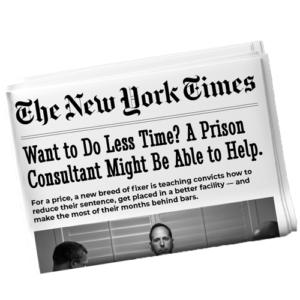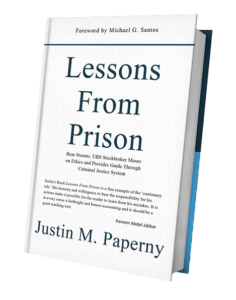Seventeen years ago, I surrendered to federal prison.
At the time, I thought I had it all figured out. I didn’t.
In our latest webinar, I reflected on that moment—and the long road that followed. We talked about the early mistakes I made, the things I wish I’d done differently, and the one idea I missed for too long: if you want a better outcome, you need to show it. Not say it. Show it. That’s what progress in prison looks like.
This wasn’t just my perspective. We were joined by Stephen Lee—a former federal prosecutor turned defense attorney—who offered brutal honesty about how defendants tank their cases without realizing it.
Lying to Your Lawyer Isn’t a Strategy. It’s a Sentence.
My biggest mistake? I lied. I lied to my lawyers. I lied to the government. I even lied to myself. I kept up the facade. I wanted my lawyers to see me the way my parents saw me. I thought if I just kept quiet or spun the story, I could soften the blow.
Stephen reinforced the cost of that lie. He’s seen firsthand how even well-paid attorneys can’t help clients who aren’t honest. If your lawyer doesn’t know the full story, they’re fighting blind. And if the government catches you in a lie? Cooperation is off the table. Your reputation is toast. Progress in prison starts long before you enter the gate—it starts with honesty.
Sentencing Memos: Read It or Regret It
Another trap I see way too often: someone calls days before sentencing and says, “My lawyer submitted the memo—I never even read it.”
If that’s you, you’re failing to participate in your own defense. Stephen echoed this. Your sentencing memo is your shot to tell the judge who you are—and who you’re becoming. It’s one of the only documents you can influence directly, and it’s the first place progress in prison should begin.
You should be reading early drafts. You should be adding to it. If you’ve been volunteering, building skills, creating a plan—put it in there. Don’t assume your lawyer knows what matters. Make sure it’s reflected clearly and credibly.
Rule 35: It’s Not a Free Pass
We talked about post-sentencing options too, especially Rule 35. That’s where the government can file a motion to reduce your sentence if you offer substantial assistance after sentencing.
But don’t get it twisted—this isn’t a guarantee. And if your only plan for showing progress in prison is whispering to a case manager that you “know something,” you’re playing a dangerous game. You have to be credible, consistent, and strategic. And you can’t talk about cooperation inside. People are listening. Always.
Want to Get Out Sooner? Document Everything.
Here’s where it gets real: the Bureau of Prisons, your probation officer, your judge—they all look for one thing post-sentencing. Are you demonstrating progress in prison?
That’s where the Prison Professors Talent platform comes in.
It’s free. It’s public. It’s designed to help you build a record that shows change. Your Talent Profile can include:
- A biography that looks forward, not back
- Journal entries that show growth and insight
- Book reports that explain what you’re reading and why it matters
- Testimonials from those who know you and support your progress
This isn’t about sounding polished. It’s about being real. Judges can spot fluff. So can probation officers. If you’re faking it or checking boxes, they’ll know.
But if you’re documenting sincere, consistent progress in prison—sharing what you’re doing, why you’re doing it, and how it’s changing you—then you’re building a record that matters.
From Ordinary to Extraordinary: Tracii Hutsona
Tracii Hutsona is a great example.
She didn’t just check boxes. She taught others inside how to prepare their own release plans. She journaled. She created lessons. She shared it with staff. And it worked. She got 11 months off her sentence without RDAP and earned a full year in the halfway house.
How? Because her progress in prison was visible. Documented. Repeated. And the judge believed it. Her case manager believed it. She wasn’t just saying “I’ve changed.” She was showing it.
Create Something That Lives Beyond Prison
You can build your own Talent Profile starting today. Upload a photo. Write your first journal entry. Record a voice memo and have someone transcribe it. Add testimonials from friends or mentors. Keep it simple—but consistent.
The most powerful stories we’ve seen come from people who start early and keep going. A week from now, you could have three solid blog entries and a release plan. A month from now, you could have a full record of progress in prison that changes how you’re viewed.
And yes, your judge might actually read it. So might your probation officer. We’ve seen it happen.
What Does Progress in Prison Really Look Like?
Progress in prison isn’t just classes and jobs. It’s not walking laps or cooking eggs in the chow hall.
Progress in prison means:
- Developing a deeper sense of accountability
- Building something for the future—even if it’s just a blog post or book report
- Making commitments you can keep
- Teaching others what you’re learning
- Asking for help when you need it—and offering it when you can
This is how you build a case for leniency, trust, and early release. And this is how you get back home stronger than when you left.
Final Thought
You don’t need to be perfect. You just need to begin.
Whether it’s a blog, a voice memo, or a scanned book report, get something down. Make it honest. Make it real. And keep doing it. That’s what the people deciding your fate are looking for.
They’re not impressed by perfection. They’re moved by effort.
And effort—sustained and visible—is what progress in prison is all about.
Want help getting started?
👉 [Insert URL] — Begin your profile today. Document progress in prison the right way.
Justin Paperny




